Fox Racing Friday | Jeff Emig’s 1997 Kawasaki KX250
Share
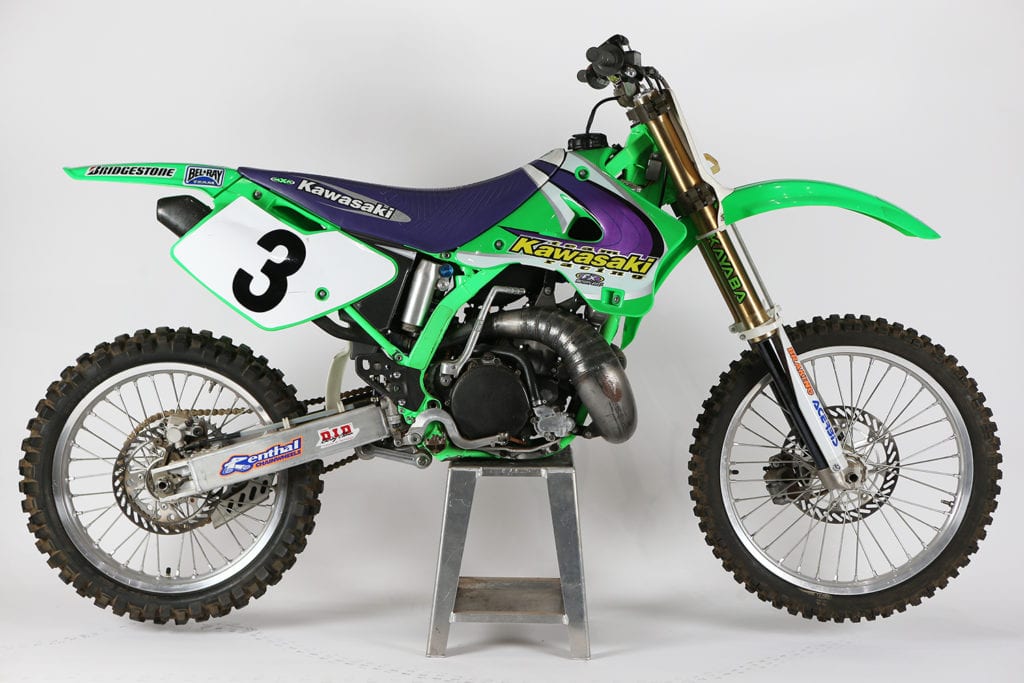
Fox Racing Friday | Jeff Emig’s 1997 Kawasaki KX250
Presented by Fox Racing
Behind the locked doors that lead to the inner sanctum of the Fox Racing HQ in Irvine, California, are several very special bikes that have important roles in motocross, Supercross, and freestyle MX history. Among them, is a very special race bike, namely Jeff Emig’s 1997 Kawasaki KX250, the very bike he captured the1997 250 Supercross Championship on. “When the new Fox Racing building was being completed, Pete Fox asked me if I had any memorabilia that I would contribute, and I figured that more people would enjoy the bike on display at Fox than in my garage at home,” said Emig. “Something like that bike should be on display somewhere rather than in a private collection, anyway.”
After Emig earned both the Supercross and 250 National Championships in 1997, he was able to persuade his Kawasaki bosses to let him keep one of his race bikes. “Back then, that certainly wasn’t the practice,” said Emig, who also owns his 1992 Yamaha YZ125 that he won the 125 National Championship on that year. “I had to have a clause put into my Yamaha contract so that I would get my championship bike, and I think I had something similar with Kawasaki.”
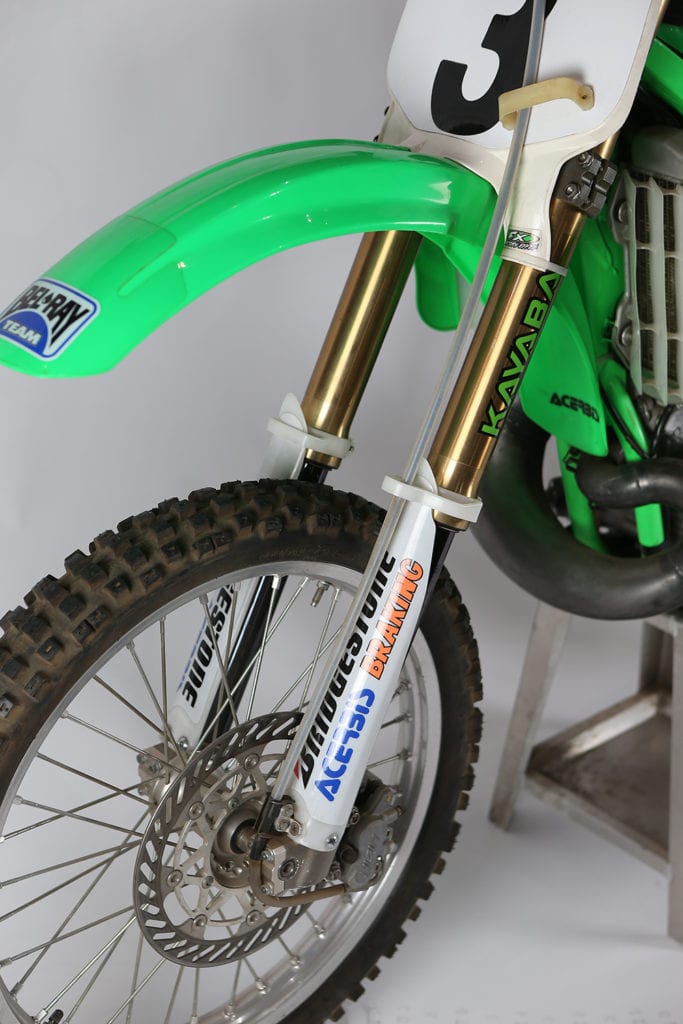
And the bike is nearly 100% genuine and intact; only the Kayaba fork on the machine is not an accurate representation of what he raced with. “Back then, the works Kayaba fork was actually gas-charged,” said Emig’s former mechanic Jeremy Albrecht. “That was actually the fork Jeff liked best throughout his career, and the same went for Ricky Carmichael. It was a horribly complicated design – it had both a mechanical spring and a gas-charged chamber – and it was expensive, too. Because there was no chance of the technology ever finding its way into production, the design eventually went away, but the fork from the ’97 bike was definitely removed and used again in ’98.”
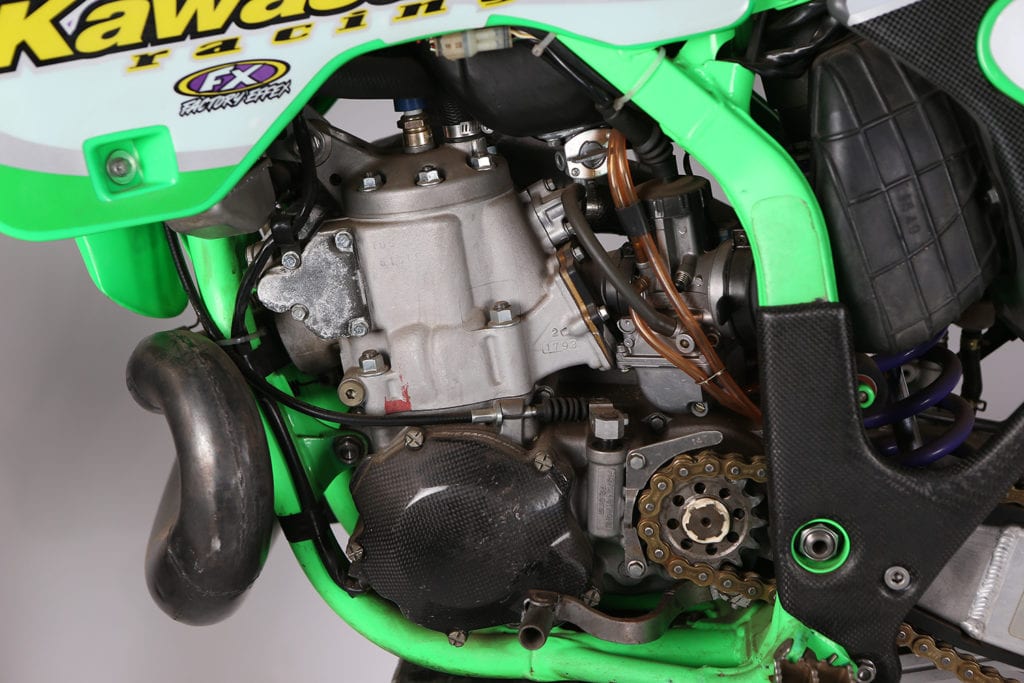
“We did a lot of engine testing that year,” remembers Emig. “The factory motor put out a lot of power, and I got a lot of holeshots that season.”
“Back then, the team’s motorman Rick Ash would modify all of the engine parts, but it was up to the mechanics to tear down and rebuild the engine every week,” added Albrecht. “Two strokes were much simpler so the job was all on you, and if there was an engine failure it was all on the mechanic. In this day and age of four-strokes it is much more complicated and teams have dedicated engine builders and all the mechanics have to do with the engine is put it into the frame.”
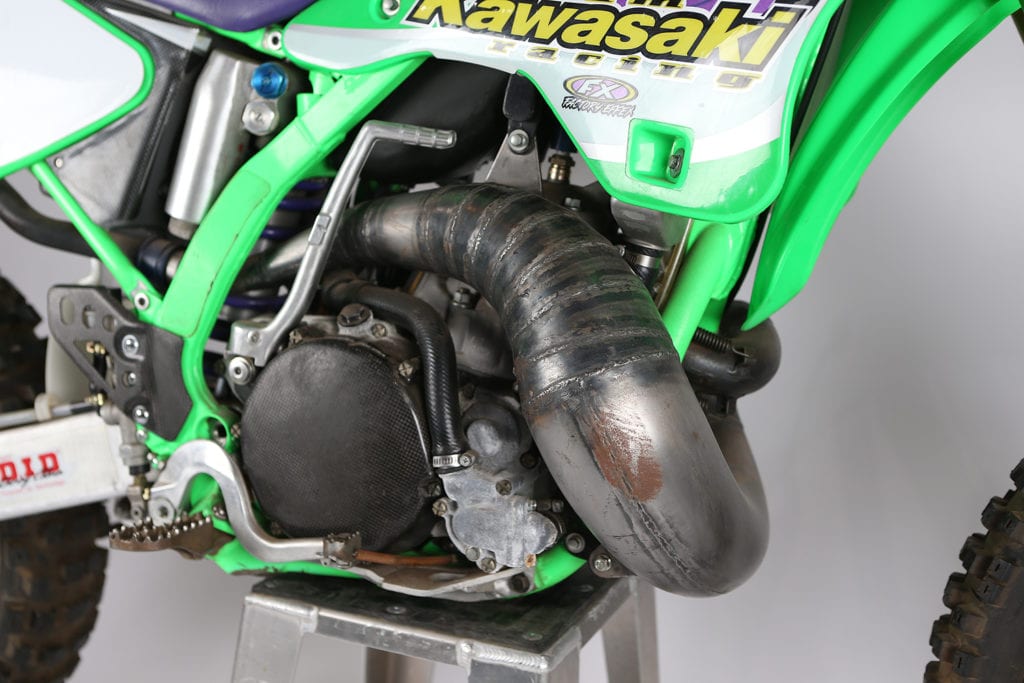
“One of the memories about that bike that really stands out to me is the pipe,” said Albrecht. “Emig loved that pipe…the T9. We would test dozens of factory pipes, but he always returned to that one. I also believe that ’97 was the first year we had TPS on our factory bikes (throttle position sensors) and that made things a lot more interesting as far as tuning went.”
One of the things that stands out about the old factory bike now is the oxidation on the engine cases that has occurred over the years. “That’s the nature of magnesium,” said Emig. “It’s a very light material, but it isn’t the most durable over time. There were always lots of mag parts on our factory bikes…”
We asked Emig what stood out to him about the old steel-framed motorcycles. “It’s funny. because we always wanted our race bikes to feel like our practice bikes which were all stretched out but felt familiar,” said Emig. “You’d show up at the races and the bike would feel a lot taller with a firmer seat foam than the bike we had ridden all week long. The sweet spot for me in a frame was a couple of races down.”
“Back then, we would replace the frames every two or three races because the steel would stretch and fatigue,” added Albrecht. “When Jeff was on the team we automatically replaced the chassis, but years later when James Stewart came along we would measure the frames and replace them as needed, which was actually far more often.”
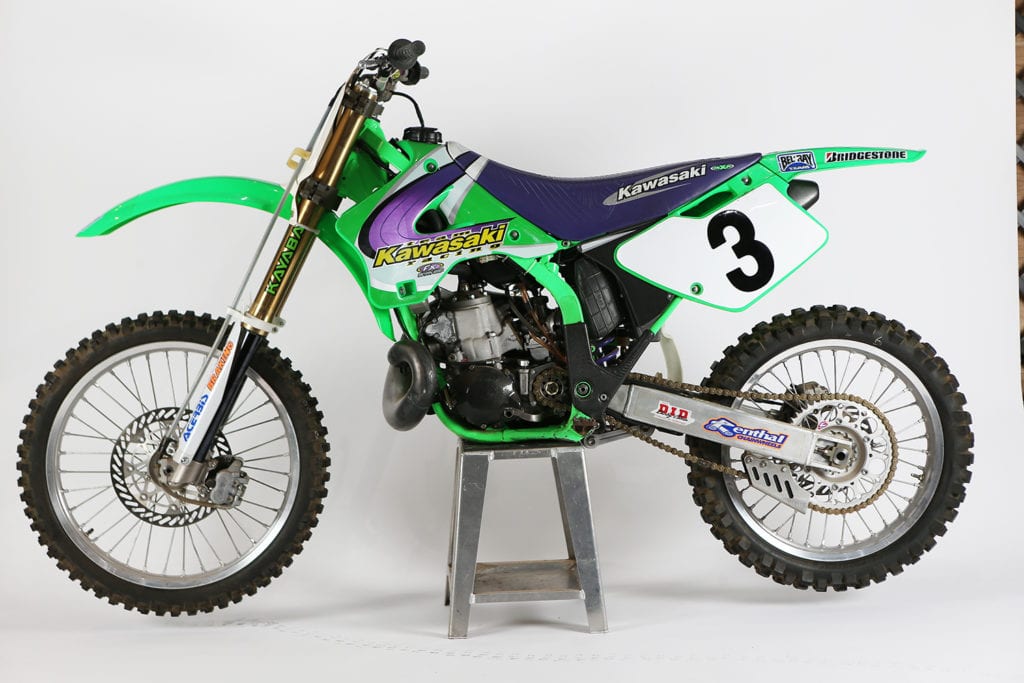
The 1997 season also marked the debut of the florescent green color scheme of the factory Kawasakis. The bike’s frame was powder-coated florescent green and Acerbis manufactured the bright plastics. “That was really cool and different,” said Emig. “It was a big departure from the standard Kawasaki lime green back then, and I think even today the Kawasaki green has changed. From what I remember, the stuff tended to fade pretty quickly and needed to be replaced.”
“The florescent green bike was Team Manager Roy Turner’s idea,” remembers Albrecht. “He wanted to stand out, to make a statement, and I remember the Kawasaki bosses didn’t want to do it. We had to keep the bikes covered up in the shop under tarps until right before Anaheim 1.”
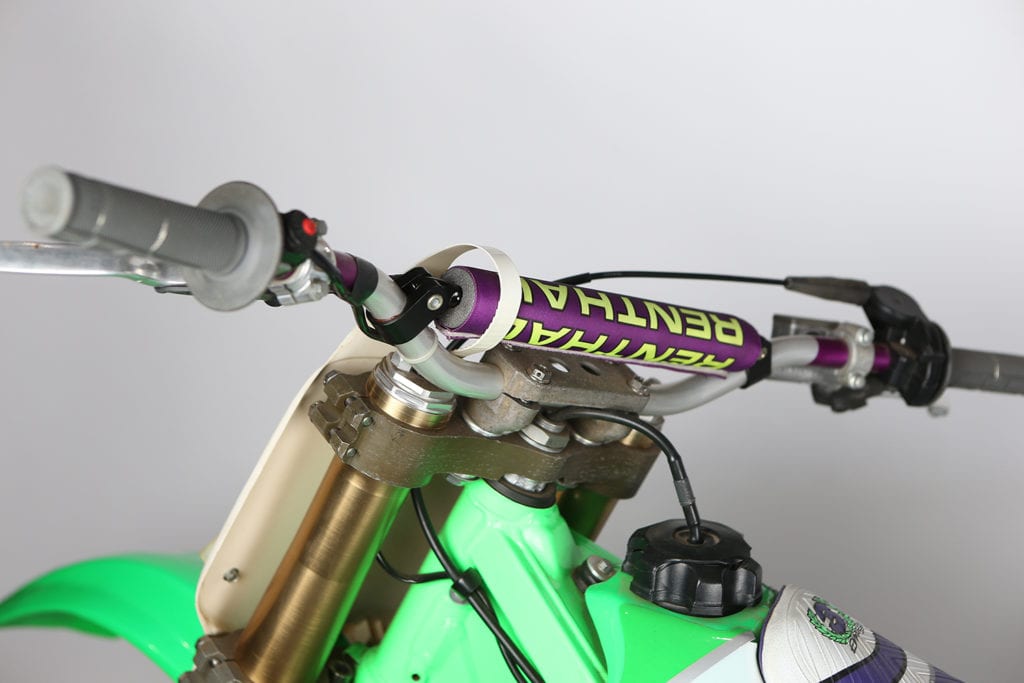
A look at the control panel of Emig’s machine revealed 7/8″ Renthal handlebars and – surprisingly – a stock clutch perch. “I actually raced with a clutch perch that we made at Emig Racing,” said Jeff. “We must have removed it to put on another bike…I didn’t race with a stock clutch perch and lever assembly!”
One of the things Albrecht remembers most about the setup of Emig’s controls is the mushy front brake he preferred. “Jeff was always very particular about the placement of his clutch and brake levers. But the one thing he was super picky about was his front brake, which didn’t activate until the lever was practically at the handlebars. No one who ever tried his bike liked it set up that way, but Jeff had to have it really mushy like that.”
Like the engine cases and covers, the works triple clamps and handlebar mount are made of magnesium.
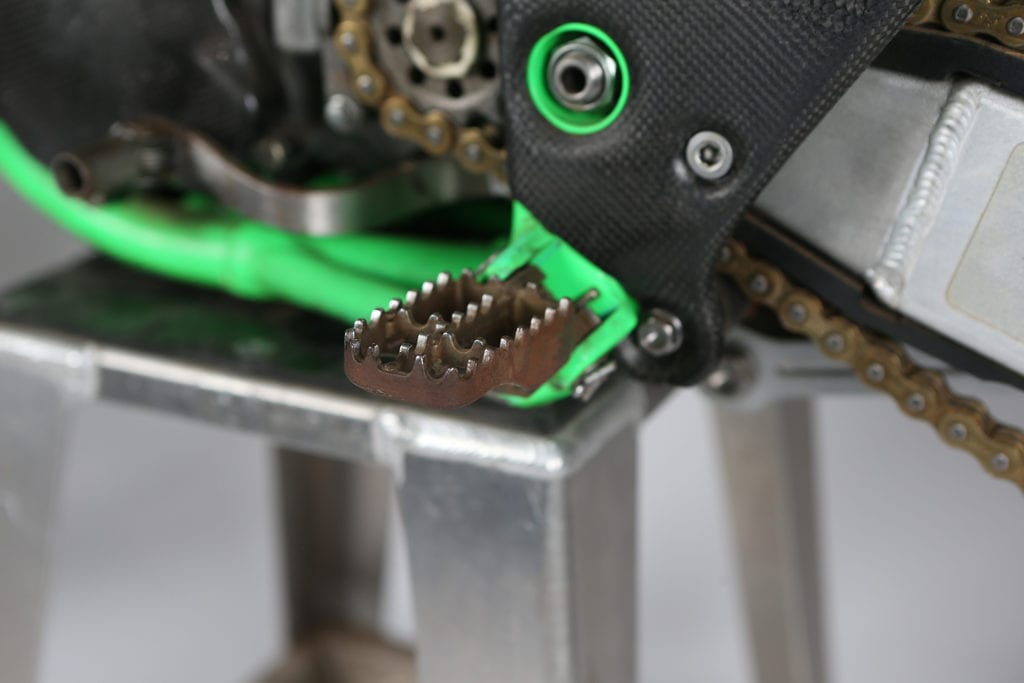
Another eye-catching thing about Emig’s machine are the footpegs, which are by today’s standards incredibly narrow. “Back then they seemed like bear traps,” said Fro. “But compared to the ones that even come stock nowadays, they do seem pretty skinny don’t they?”
We asked Emig where he saw his 1997 Kawasaki KX250 in say, 20 years from now. “If it’s not at Fox, it will probably be in an AMA museum somewhere. Like I said before, a bike like this should be displayed for people to enjoy.”
Editorial Fox Product Spotlight of the Week
 Fox V3 Helmet featuring Fluid Inside
Fox V3 Helmet featuring Fluid Inside
Price: $499.99
The Details
Introduced last month, the all-new Fox V3 Helmet boasts a wealth of new design and safety features that make it stand out from other premium off-road motorcycle helmets. At the heart of the new helmet is an all-new MCT (multi-composite technology) shell that comes in four shell sizes, and is paired with a Varizorb EPS liner, which features multi-density foam to help disperse impact energy more efficiently thanks to its cone-shaped injected design. To address the dangers of rotational impacts, Fluid Inside technology is incorporated into the inside of the helmet, between the EPS and comfort liner. The fluid pods are designed to mimic the cerebral fluid that protects your brain from coming into contact with the inside of your skull, offering both linear and rotational impact dampening. In total, seven Fluid Inside pods are spread throughout the helmet to help disperse impacts in a crash. Another unique feature of the new V3 helmet is its two-piece construction. While the main shell is traditional in design, the entire eyeport and chinbar is a separate piece, dubbed The Cage. Made of composite materials, the piece is designed to offer impact energy management than a traditional one-piece design. The entire helmet is extensively vented, with massive ports that are protected by injected mesh screens. Finally, Fox’s patented MVRS magnetic visor system is incorporated. Designed to detach on impact in the event of a crash, the system helps guard against snagging on the ground and mitigate external rotational forces.
SML Says
The all-new V3 definitely looks unlike any other motocross helmet. In fact, it looks much like the Rampage Pro Carbon mountain bike helmet we’ve come to love. What do we think of the new moto helmet, though? Having given it a thorough and complete test (unfortunately?) by suffering a massive crash in it on our first day of riding in it, we can confidently give it a two thumbs up review.
But let’s get to our pre-crash impressions, first! The new V3 fits very well, and we encountered none of the pressure points that we initially suspected that we might from the Fluid Inside pods. Instead, the helmet slips on nicely and has a soft, luxurious feel inside against your head and face. Unlike the previous V3, the new helmet has a deeper fit, and the chin bar offers plenty of clearance for your face. The previous V3’s chinbar felt close to our face and had a much different feel. We love the fit of the new helmet, and it offers a great field of vision and accepts all goggles well, even the current trend of oversized goggles from other manufacturers.
Ventilation is amazing in the V3, as air flows through the massive vents and cools your head. On cold days, we found ourselves actually cold inside the V3! As one might expect, more sound reaches your ears due to the generous venting, but that is something that only takes a few laps to grow accustomed to.
The MVRS visor is not adjustable, but the height of the visor seems just right for the majority of riders who will race in it. Trail riders might wish for a lower setting, but the standard location is proper! The MVRS is more sturdy than it was on earlier helmets, and it takes quite an impact to dislodge the visor. But, we can state from experience that it does indeed detach on impact.
The crash we had in the new V3 was pretty significant. (Switch to a first-person account, here.) An overdose of throttle in a dry, slick corner sent me into a violent high-side, and I slapped my head onto the hard-packed SoCal dirt with such force, that it rendered me kookoo for the better part of an hour. A trip to the ER for a CT scan revealed no bruising, bleeding, or swelling of my brain, and I was released with a clean bill of health and a prescription for pain killers. Initially, I was bummed out about suffering a mild concussion in the new helmet, but a few days later I connected with Mark Finley from Fox Racing and got to take a look at my crash-damaged lid. The damage done to the helmet made it obvious that the impact it protected me from was pretty damned big. Having more helmet-smashing experience than I’d like to admit, I can honestly say that the V3 likely saved my life, and I would have suffered a mild concussion at best in any helmet I could have been wearing. The brunt of the impact was in the right forehead area, and the EPS was compressed to the point that it cracked. The Cage eyeport and chinbar was completely intact, proving that the two-piece design is indeed sturdy enough to protect against big impacts.
Would I ride and race in the new Fox Racing V3 again? Absolutely. Learn more about the helmet in the video below, and see my crash-damaged V3 in the video beneath it.
- swap
















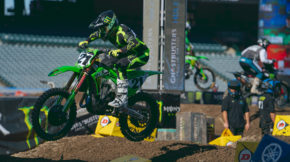
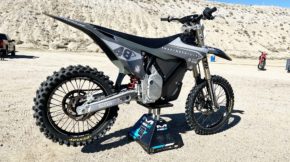
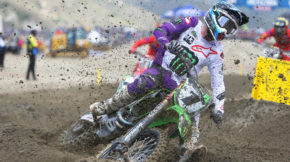
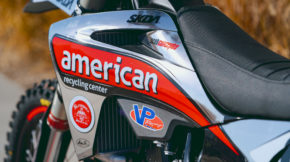
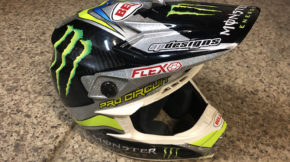
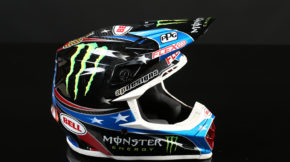
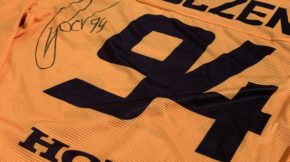
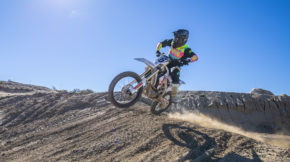
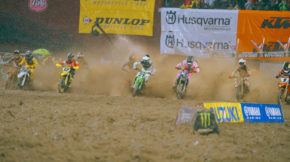
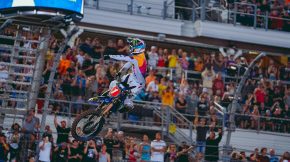
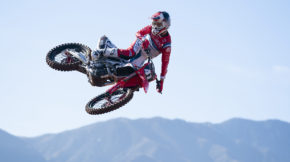
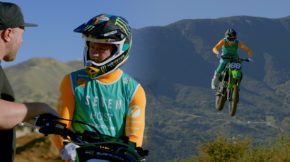
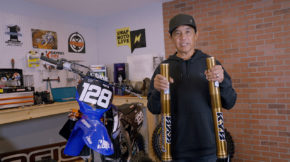

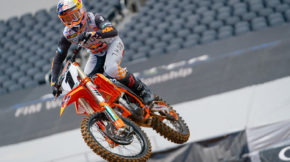
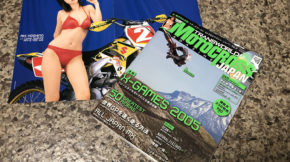
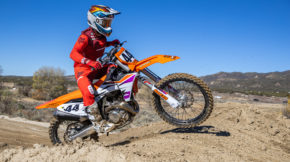
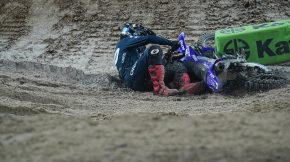
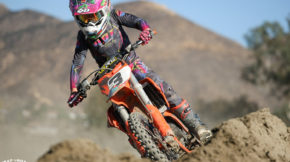
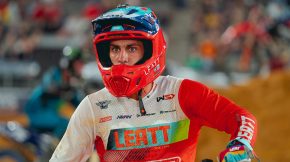
Very cool!! Man id love to tour this “museum” one day!!! Seems like id be drooling for hours! Great content and well written article